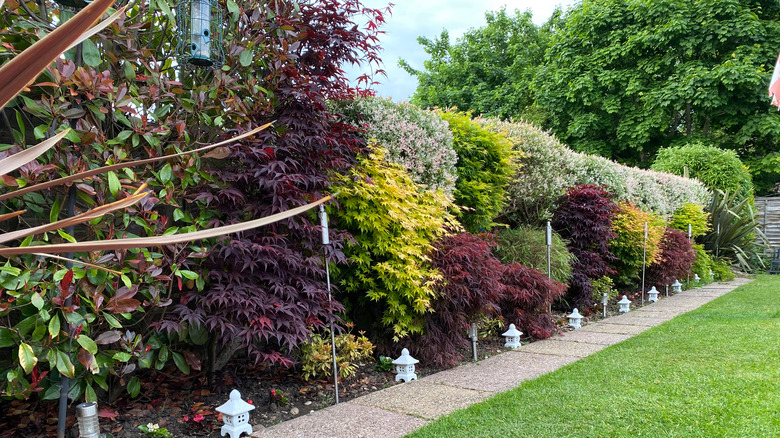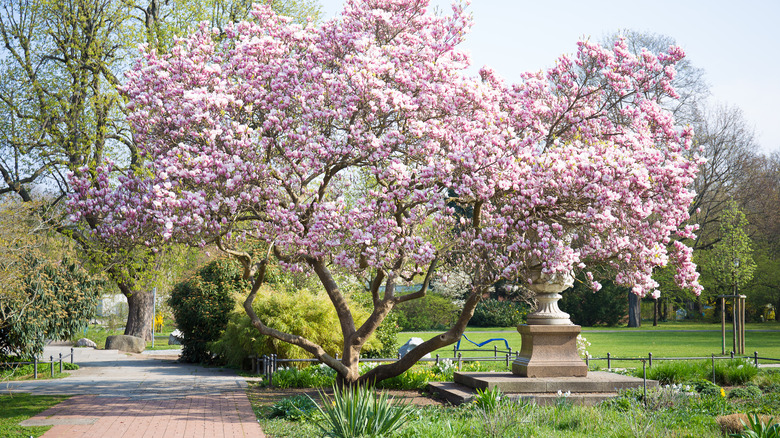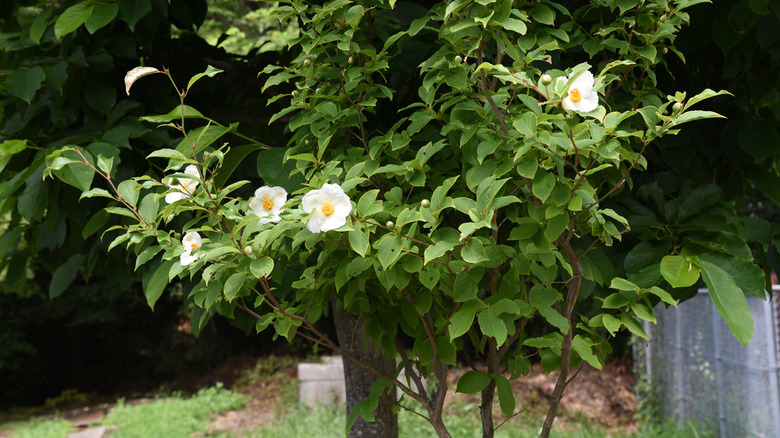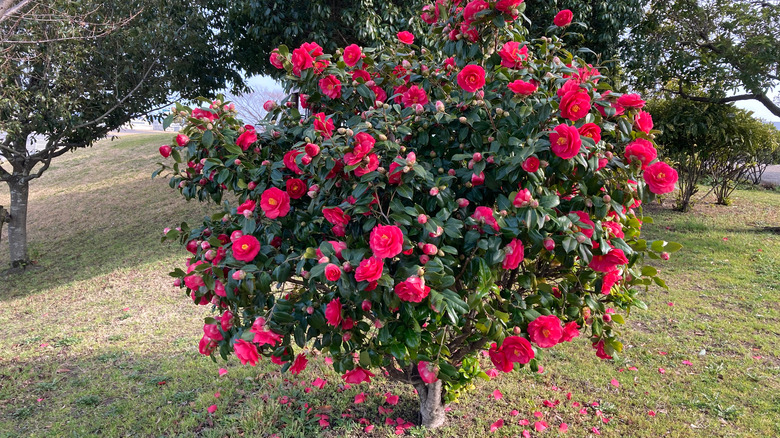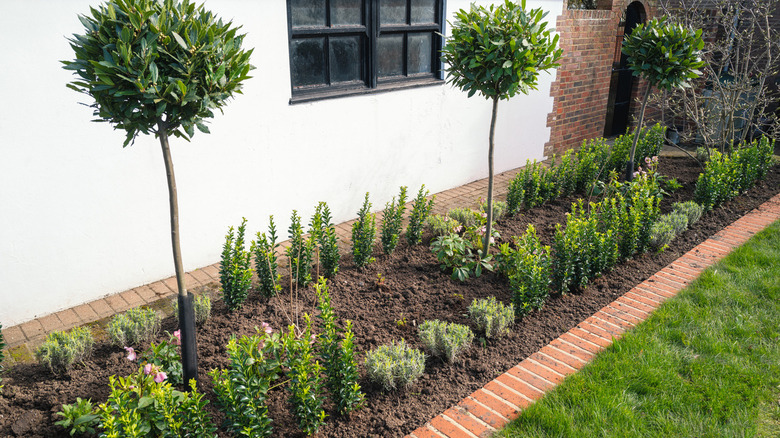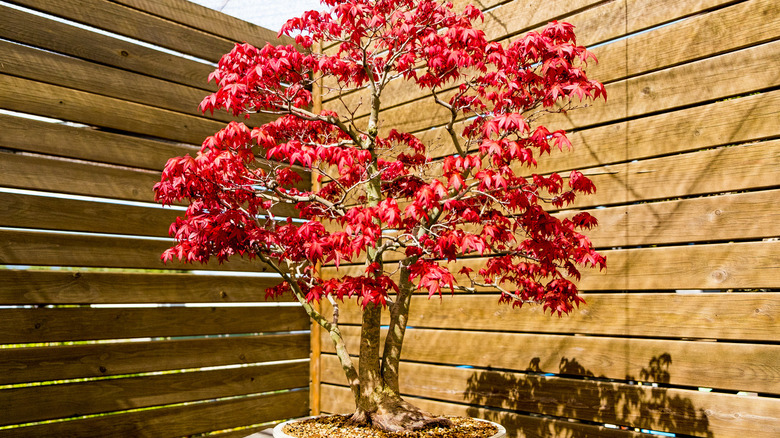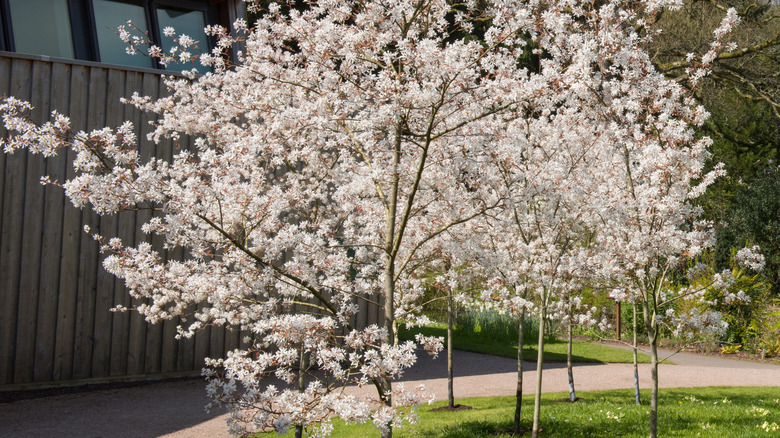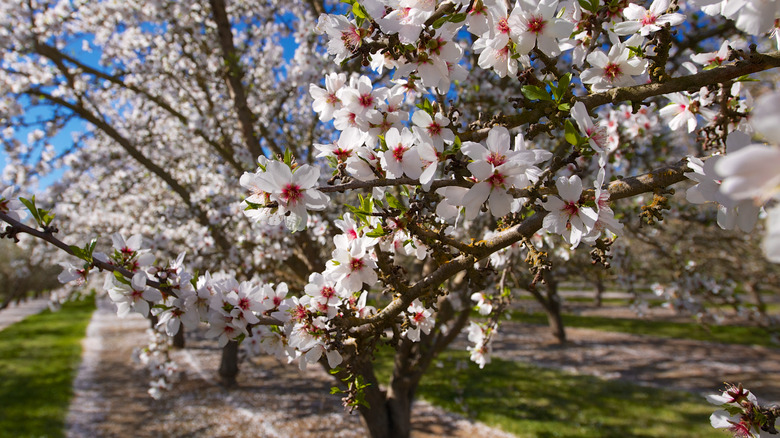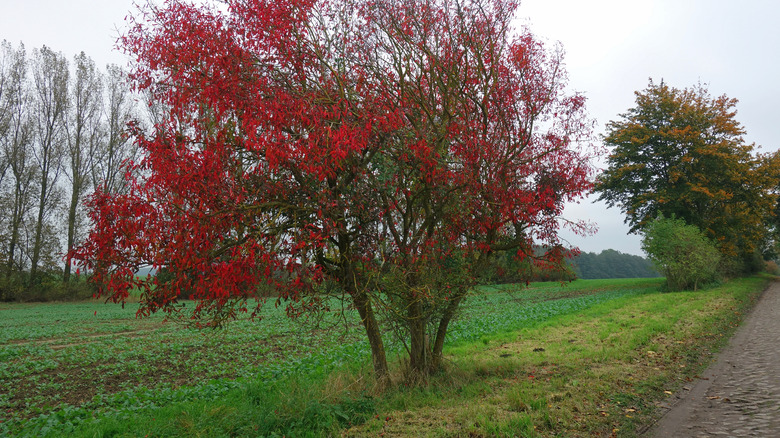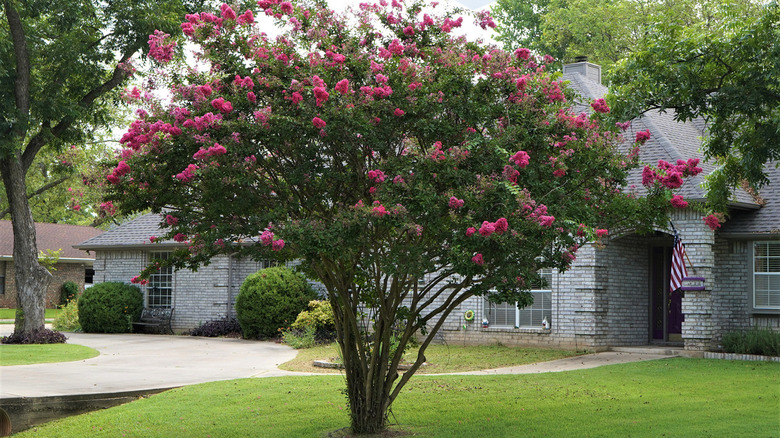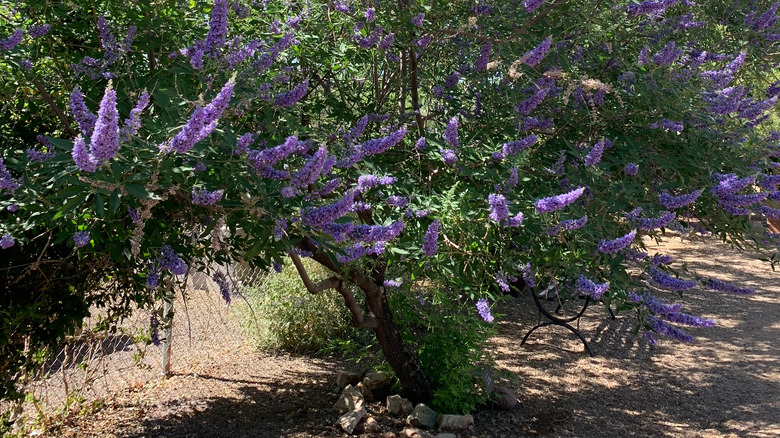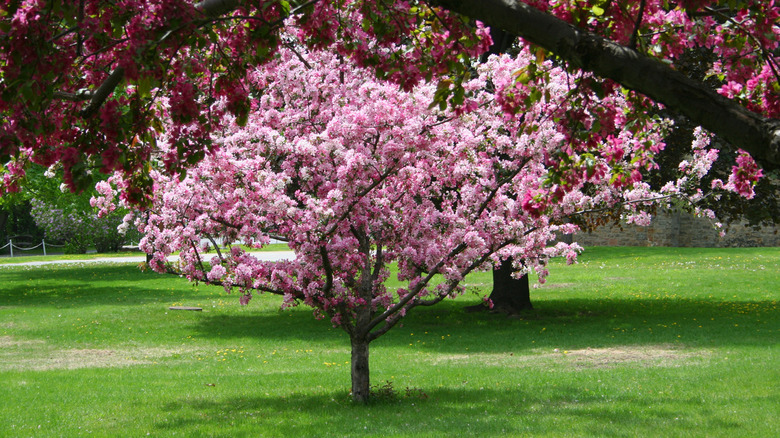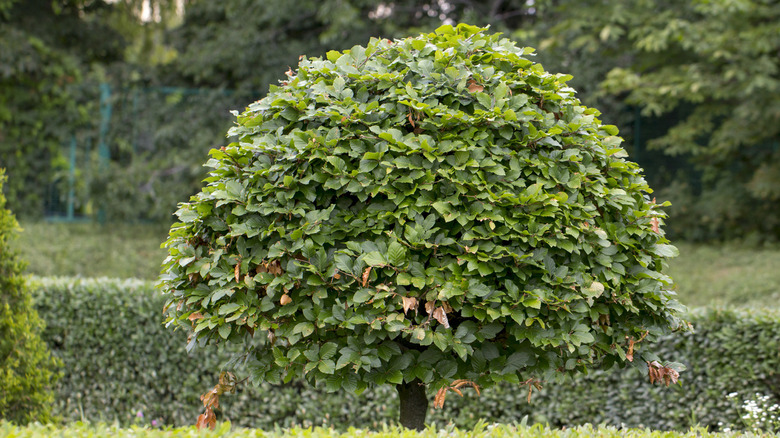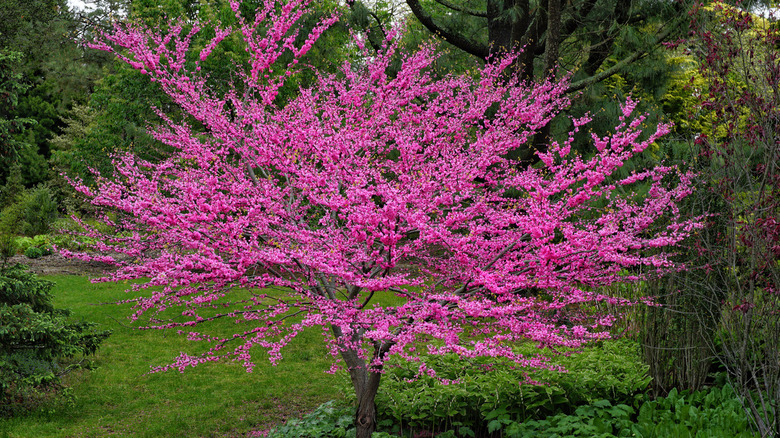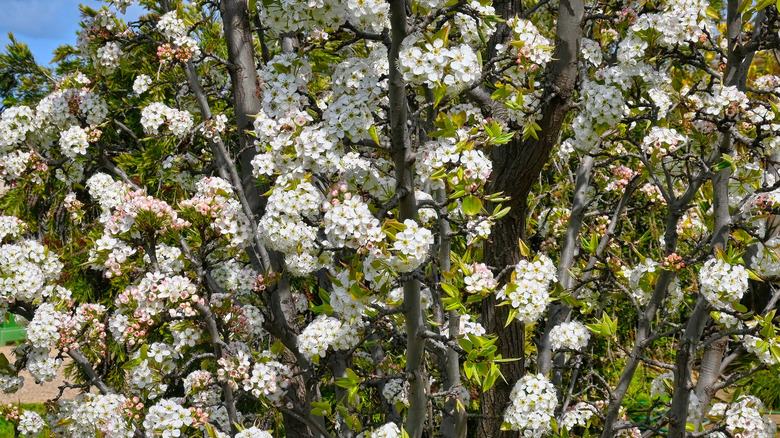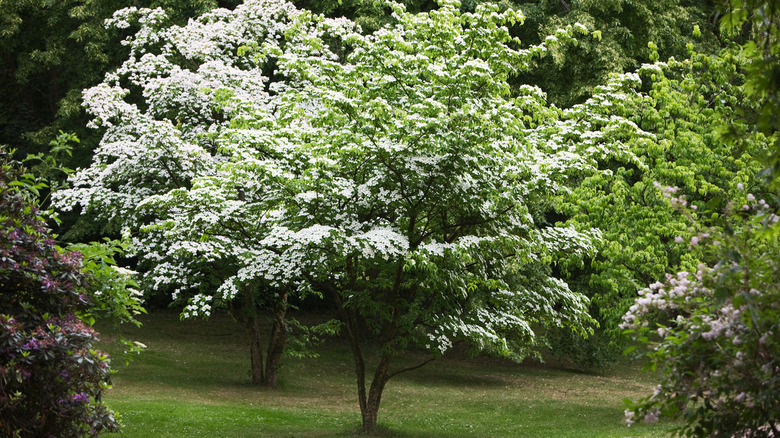15 Trees Perfect For A Small Garden
Prioritizing flowers over growing trees makes sense, especially for small outdoor gardens. Because of the sheer size of most trees, most homeowners with a small garden prioritize perennials for all the right reasons. However, for a more dramatic and balanced look, including a few trees would do your garden a lot of good. Every garden deserves a tree despite its size. Think about it — trees are ever-changing from their foliage to their flowers and there is always something new you can anticipate for every season.
When selecting the right tree for your small garden, it is easy to get spoiled for choice as there are plenty of options that you can accommodate in your small garden. While on the quest for the right tree, Arbor Day Foundation advises that you should be critical of the growth characteristics of the tree. Some tree species grow too large for a small garden, colonizing the entire space with too much shade. However, there are other varieties that, when planted in the right spots in a small garden, create a nice focal point. Remember to plant trees that are suitable for your specific region's hardiness. Here are a few options that you can take inspiration from.
1. Magnolia
The beautiful magnolia (Magnolia x soulangiana) is an ornamental tree that will steal the show in your garden every spring (via Trees for Seattle). It is also a great option for a tree in the front yard. The beautiful pink flowers fill the air with a sweet scent during spring. There are different species of the magnolia tree that vary in size, ranging from 15 feet up to 80 feet.
Bloom Season: Spring
USDA Growing Zone: 4 to 9
Growing Conditions: Full to partial sunlight
Soil Type: Well-drained rich organic soil
Size: 15 feet to 80 feet
2. Japanese stewartia
Are you in search of a short tree variety that promises all-year blooming? The Japanese Stewartia (Stewartia pseudocamellia) might be ideal for you. This tree grows thick, rich foliage and does not consume a lot of space in the garden. It is famous for its exfoliating bark that peels into strips of various colors (via North Carolina State Extension). Be sure to water this plant regularly, especially during the early stages.
Bloom Season: Summer and fall
USDA Growing Zone: 5 to 8
Growing Conditions: Full to partial sunlight
Soil Type: Acidic, well-drained, rich soil
Size: 12 feet to 40 feet tall
3. Camellia japonica
Another short and compact variety for a garden with little space to spare is the Japanese Camellia (Camellia Japonica). This tree features glossy foliage and promises beautiful blooms two times every year. They can be quite picky as far as growing conditions are concerned; however, they will reward you for the extra care. They are slow to grow but compensate by living for a very long time (via North Carolina State Extension).
Bloom Season: Fall, winter, spring
USDA Growing Zone: 7 to 9
Growing Conditions: Partial sunlight
Soil Type: Acidic, well-drained, rich soil
Size: 7 feet to 12 feet tall
4. Bay laurel
Even the tiniest of garden spaces can accommodate one or two bay laurel trees (Laurus nobilis). You have probably used bay leaves in your meals — now it is time to grow some in your small garden. This tree can grow in pots, and its straight stature gives it ornamental value, especially when trimmed into a neat ball. It has shallow roots that need watering during the dry months (per University of Florida Gardening Solutions).
Bloom Season: Late spring, early summer
USDA Growing Zone: 8 to 10
Growing Conditions: Full to partial sunlight
Soil Type: Moist, well-drained soil
Size: 10 feet to 60 feet tall
5. Japanese maple
The Japanese maple (Acer palmatum) is a popular tree variety because of its colorful foliage that creates interest all year round. There is always something to anticipate for every season if you have this tree. This plant has several varieties right from dwarf species to huge varieties fit for larger gardens. It will require watering during the early stages after planting but is technically maintenance-free once established (via Monrovia).
Bloom Season: Between May and June
USDA Growing Zone: 5 to 8
Growing Conditions: Full to partial sunlight
Soil Type: Slightly acidic, well-drained soil
Size: 2 feet to 30 feet tall
6. Serviceberry
The Serviceberry (Amelanchier spp.) is an ornamental deciduous tree featuring attractive white flowers that demand attention. Other than the bright white flowers, this tree's foliage also changes to brown-orange during spring. It also produces edible fruits that feed wildlife (via Wisconsin Horticulture Division of Extension).
Bloom Season: Spring
USDA Growing Zone: 2 to 7
Growing Conditions: Full sun and partial shade
Soil Type: Acidic, moist, well-drained soil
Size: 15 feet to 25 feet tall
7. Flowering almond
The flowering almond (Prunus glandulosa) is more of a shrub than a tree. It is a dwarf variety that is ideal for a small garden. This deciduous bush has five-petal flowers that can be either white or pink in color. The flowering almond is a great plant to combine with other shrubs for creating a small animal habitat in your garden (via University of Arkansas Division of Agriculture).
Bloom Season: Spring
USDA Growing Zone: 4 to 8
Growing Conditions: Full sun and partial shade
Soil Type: Well-drained, neutral soil
Size: 4 feet to 5 feet tall
8. Euonymus
The Oregon State University College of Agricultural Science mentions that the Euonymus europaeus tree is an ornamental deciduous shrub that has all the characteristics of a Euonymus species. The branches grow rounder and wider as the tree matures. It is the perfect tree to grow as a focal point of your garden or front yard because of the colorful foliage during autumn.
Bloom Season: Spring
USDA Growing Zone: 4
Growing Conditions: Full sun and partial shade
Soil Type: Rich, well-drained soil
Size: 12 feet to 30 feet tall
9. Zuni crape myrtle
The Zuni crape myrtle (Lagerstroemia indica x fauriei) is a relatively small tree popular in urban setups. It grows wide and blooms into lavender or pink colors that can be a good accent to a rather unappealing wall, mentions Monrovia. Depending on the size of your garden, you can plant two or more Zuni trees to compound the canopy effect. Remember to give the plant a proper drink during the dry hot months.
Bloom Season: Midsummer
USDA Growing Zone: 6 to 10
Growing Conditions: Full sun
Soil Type: Rich, well-drained soil
Size: 9 feet to 12 feet tall
10. Chaste tree
Often referred to as the Vitex agnus-castus, it is a good choice for a small garden. It is more of a shrub than a tree that blooms longer, making it worth your while. According to Texas Agrilife Extension Service, you will be required to prune this plant in order to give it some shape. It doesn't need too much care once established and you may never need to water this tree at all.
Bloom Season: Late spring to early fall
USDA Growing Zone: 6 to 9
Growing Conditions: Full sun
Soil Type: Well-drained soil
Size: 15 feet to 20 feet tall
11. Crabapple
Small compact tree varieties like the crabapple (Malus spp) are a must-have for any small garden space. While there are large varieties that might not be suitable for a small garden, consider the dwarf options that are equally ornamental, if not more. The Tree Center advises against pruning the crabapple tree — instead, let it grow naturally.
Bloom Season: Late spring
USDA Growing Zone: 4 to 8
Growing Conditions: Full sun
Soil Type: Rich, well-drained, loamy soil
Size: 15 feet to 20 feet tall
12. The American hornbeam tree
The American hornbeam (Carpinus caroliniana) is a slow-growing tree species that you should consider for your small garden. This tree is native to America and features deep green leaves that change colors depending on the season, per North Carolina Extension. This tree requires regular watering, especially during the hot summer months.
Bloom Season: April to June
USDA Growing Zone: 3 to 9
Growing Conditions: Partial to full shade
Soil Type: Well-drained, fertile soil
Size: 20 feet to 35 feet tall
13. Eastern redbud
The Eastern redbud, also referred to as Cercis canadensis, is another tree native to North America that is grown purposely for its ornamental value. It is a large shrub that grows into a vase shape and often sprouts a lot of branches (via Arbor Day Foundation). The Eastern redbud's beautiful foliage during fall and winter is admirable, and it is a guaranteed attention grabber.
Bloom Season: Spring
USDA Growing Zone: 4 to 8
Growing Conditions: Full sun to partial shade
Soil Type: Well-drained, neutral to slightly alkaline soil
Size: 20 feet to 30 feet tall
14. Ornamental cherry
The ornamental cherry (Prunus serrulata) tree is beautiful. The combination of pink and white petals during spring brings much-needed drama and attention to your garden. The ornamental cherry species have both tall and small varieties that are ideal even for gardens with smaller spaces. This tree loves moisture; therefore, it is recommended to water frequently and also add a layer of mulch (via Nature and Garden).
Bloom Season: Spring
USDA Growing Zone: 5 to 8
Growing Conditions: Full sun
Soil Type: Well-drained, neutral, loamy soil
Size: 15 feet to 25 feet tall
15. Chinese dogwood
Are you looking to introduce some color to your outdoor garden? The Chinese dogwood (Cornus Kousa) will do that for you. This ornamental tree promises four-season interest and blooms late into spring. It initially grows in a vase shape but takes a more widespread shape in maturity (via North Carolina Extension). It doesn't have a lot of maintenance practices other than keeping the soil moist.
Bloom Season: May to June
USDA Growing Zone: 5 to 8
Growing Conditions: Full to partial shade
Soil Type: Slightly acidic, well-drained soil
Size: 15 feet to 30 feet tall

